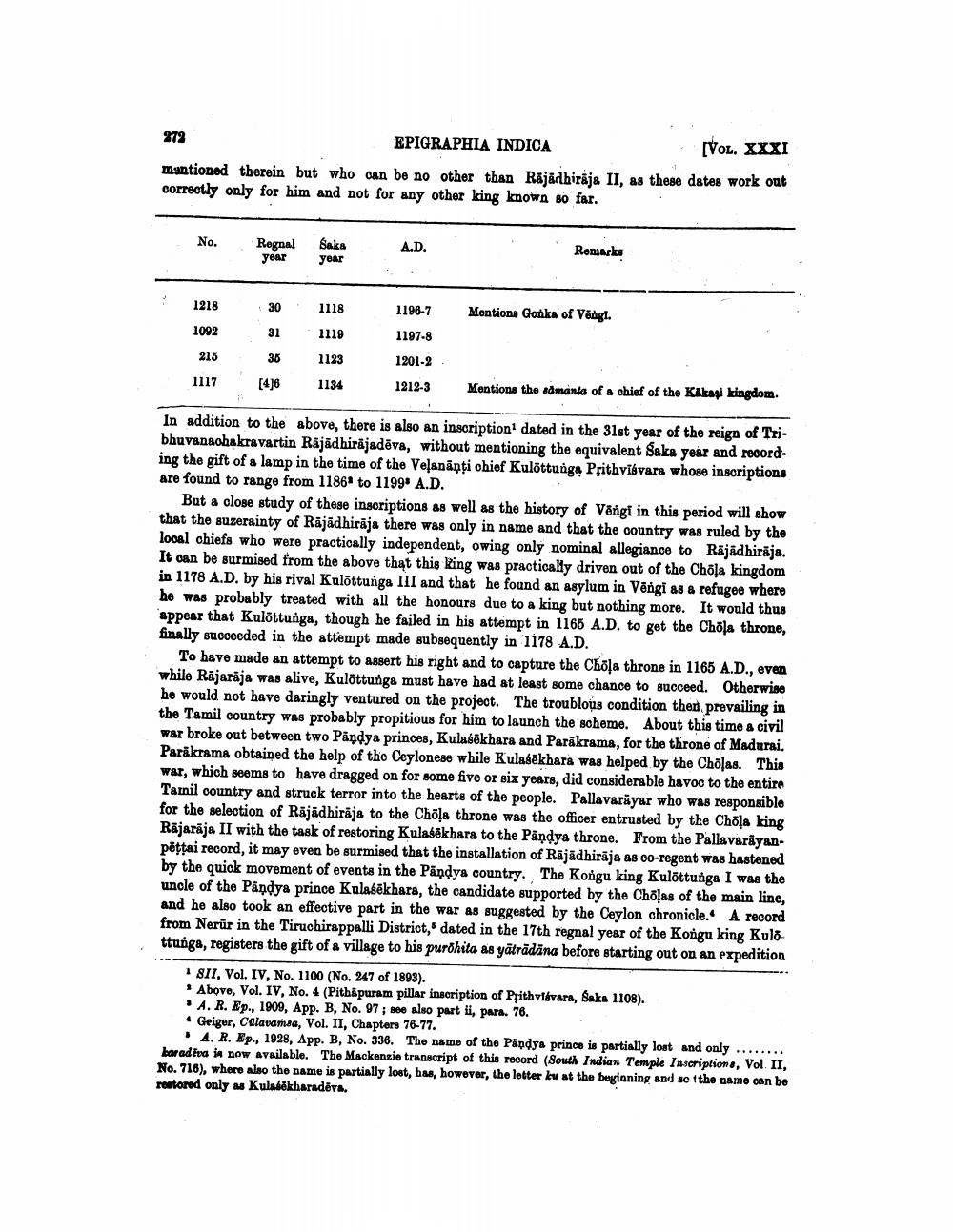________________
379
EPIGRAPHIA INDICA
[VOL. XXXI mantioned therein but who can be no other than Rajadhiraja II, as these dates work out correotly only for him and not for any other king known so far.
No.
A.D.
Regnal year
Saks yo&r
Remarks
30
.
1196-7
Mentions Gonka of Vengt.
1197-8
1218 1092
215 1117
1118 1119 1123 1134
36 [436
1201-2 1212-3
Mentions the smanta of a chief of the Kikapi kingdom.
In addition to the above, there is also an inscription dated in the 31st year of the reign of Tribhuvanaohakravartin Räjädhirajadēva, without mentioning the equivalent Saka year and record ing the gift of a lamp in the time of the Velanänţi chief Kulöttunga Prithvisvara whose inscriptions are found to range from 11869 to 1199. A.D.
But a close study of these inscriptions as well as the history of Vângi in this period will show that the suzerainty of Rājādhirāja there was only in name and that the country was ruled by the local chiefs who were practically independent, owing only nominal allegiance to Rājādhiraja. It can be surmised from the above that this king was practically driven out of the Chola kingdom in 1178 A.D. by his rival Kulottunga III and that he found an asylum in Vēngi as & refugee where he was probably treated with all the honours due to a king but nothing more. It would thus 'appear that Kulöttunga, though he failed in his attempt in 1166 A.D. to get the Chola throne, finally succeeded in the attempt made subsequently in 1178 A.D.
To have made an attempt to assert his right and to capture the Chola throne in 1165 A.D., even while Rājarāja was alive, Kulõttunga must have had at least some chance to succeed. Otherwise he would not have daringly ventured on the project. The troublous condition then prevailing in the Tamil country was probably propitious for him to launch the scheme. About this time a civil war broke out between two Pandya princes, Kulasēkhara and Paräkrama, for the throne of Madurai. Parakrama obtained the help of the Ceylonese while Kulasēkhara was helped by the Chöļas. This war, which seems to have dragged on for some five or six years, did considerable havoc to the entire Tamil country and struck terror into the hearts of the people. Pallavariyar who was responsible for the selection of Räjādhiraja to the Chola throne was the officer entrusted by the Chola king Rājarāja II with the task of restoring Kulasēkhara to the Pandya throne. From the Pallavarayanpēttai record, it may even be surmised that the installation of Rājādhirāja as co-regent was hastened by the quick movement of events in the Pandya country. The Kongu king Kulottunga I was the uncle of the Pandya prince Kulasēkhara, the candidate supported by the Cholas of the main line, and he also took an effective part in the war as suggested by the Ceylon chronicle. A record from Nerür in the Tiruchirappalli District, dated in the 17th regnal year of the Kongu king Kulottunga, registers the gift of a village to his purðhita as yātrādāna before starting out on an expedition
18I1, Vol. IV, No. 1100 (No. 247 of 1893).
Abovo, Vol. IV, No. 4 (Pithapuram pillar inscription of Prithvidvara, Saka 1108). • A. R. Ep., 1909, App. B, No. 97; see also part ii, para. 76. • Geiger, Cülavamsa, Vol. II, Chapters 76-77.
4. R. Ep. 1928. App. B, No. 336. The name of the Pandya prince is partially lost and only ........ baradeva ja now available. The Mackenzie transcript of this record (South Indian Temple Inscriptions, Vol. II, No. 716), where also the name is partially lost, has, however, the letter les at the begioning and so Itho namo oan be rostored only as Kulasēkharadēva.




